Arthrosis is the most common of all diseases of the musculoskeletal system. The knees are very prone to it, as they bear most of the load. Let's take a closer look at what arthrosis of the knee joint is and how to deal with this disease.
Characteristics of this disease
Arthrosis of the knee joint is a pathology associated with the development of degenerative-dystrophic processes in the cartilage tissue of this joint. As the disease progresses, the disease affects not only the cartilage itself, but also other tissues, including the periarticular ligaments and muscles, and over time, processes can develop that contribute to bone destruction.
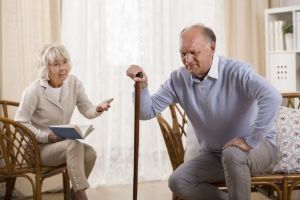
Risk Group
As we age, the body experiences difficulties that lead to tissue malnutrition and accelerate thirst. Under the influence of mechanical, biochemical, and other factors, cartilage tissue gradually begins to deteriorate, which then develops into arthrosis of the right knee joint or left joint.
With age, the frequency of these pathological diagnoses increases. Women are particularly prone to the development of gonarthrosis, which is due to the changing characteristics of their body and hormones.
Also at risk are athletes and people whose jobs are related to weight lifting and constant load on the legs.
In general, the following risk groups can be distinguished:
- elderly;
- athlete;
- people with knee injuries;
- patients who have undergone surgery on the knee joint;
- is inactive;
- fat;
- is associated with difficult physical work or the need to constantly strive;
- patients with endocrine diseases;
- people with hormonal disorders;
- living an unhealthy lifestyle;
- with congenital pathology of the musculoskeletal system.
When entering a risk group, you must regularly monitor the condition of your joints, as well as take precautionary measures.
Reason for development
If we discuss the specific causes of dystrophic processes in cartilage tissue, it has a lot to do with a person's daily life. Existing health problems also play a role.
The main causes of gonarthrosis are:
- Injury. All damage to the knee and adjacent tissues, namely bruises, dislocations, tears and sprains, cracks, fractures, and others. The result may be a few seconds after the injured area has completely healed.
- Congenital disorders. These include, for example, articular joint instability, curvature and developmental disorders and other functions related to structural features of the human skeleton.
- Age change. Gradually, the cartilage tissue is depleted, and calcium is washed out of the bone. The older a person gets, the clearer the process.
- Obesity. Being overweight slows down metabolic processes and contributes to excessive stress on the limbs. Obese people almost always have leg problems.
- Endocrine diseases.Unhealthy endocrine system conditions cause hormonal imbalances and metabolic disorders.
- Operating intervention. Surgical manipulation of the meniscus has a very strong effect. When it is removed, gonarthrosis develops in 90% of cases.
- Pressure. Strong emotional experiences negatively affect the state of the whole organism, including elements of the musculoskeletal system.
- Tissue nutrient deficiency. Often, this process is associated with impaired blood circulation, because through the ducts in the tissues all the necessary nutrients are supplied.
- Heavy load.Lifting and carrying loads, running and jumping incorrectly, violations of technique of doing physical exercises, standing for a long time - all of these are excessive loads on one's feet.
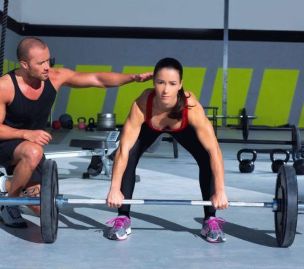
If you do not take steps to prevent the influence of this cause, the careless cost of your health care will be indicated by many problems with the musculoskeletal system and other body systems.
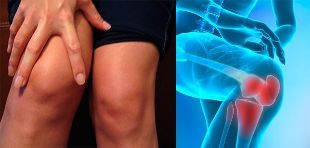
Manifestation Symptoms
Initially, the disease is not symptomatic or anxiety occurs only occasionally. Most knees begin to ache after a long stay in one position or an intense day at work. Since the symptoms do not bother and disappear completely after rest, a person does not immediately realize that he has a serious health problem.
Gradually, discomfort increases, severe pain appears. They hurt naturally, but as they move, they become sharp and sudden. As the disease progresses, discomfort increases.
Other symptoms of gonarthrosis are:
- deterioration of knee motor capacity;
- the appearance of soundless cramps when moving;
- swelling and tissue hyperemia;
- limb curvature.
This is the desire to relieve pain which is often a major stimulant factor for a person to refer to a clinic. The sooner you do this, the more chances you have of stopping the pathological process. Otherwise, the change will be irreversible and impossible to solve problems with conservative methods.
An increase in temperature is observed in some cases. This phenomenon is rarely observed, this indicates a strong inflammatory process. It may be due to an infection, for example, if you have recently suffered a leg injury.
Type of pathology
In medical practice, this disease has a special classification.
There are the following types of knee joint arthrosis:
- Left or Right. It is localized on only one side, which affects the left or right knee. Often, this condition occurs after an injury to a limb.
- Two sides. At the same time, pathological processes develop in both legs. The symmetrical development of this disease is special for most cases, because the internal processes in the human body have a great influence.
- Main. It develops as a disease free. Provoking factors are improper lifestyle, stress, age-related changes, etc.
- Secondary. Gonarthrosis is the result of other diseases of the system and the musculoskeletal system that are closely related to it. Also included in this category are traumatic injuries to the limbs.
It is also necessary to distinguish between periarthrosis. The disease involves the muscles and ligaments, through which the articular joints move.
Another important category is knee hyperarthrosis. This is the name for a progressive degenerative process in cartilage. In the latter stage, there is significant deformed gonarthrosis. Need to discuss the stage of pathological development in more detail.
Developmental level
There are four main stages of knee arthrosis. Each of them is distinguished by a clearer manifestation of the disease and the emergence of new negative processes.
- Level 1. Sometimes discomfort occurs, but after resting and exercising in the legs, disappears. There are still no changes in tissue structure that can be seen by a diagnostician, but cartilage nutrition is already disrupted, which gradually provokes the development of pathology.
- Stage 2. The pain becomes irritating, the cartilage becomes thinner, causing narrowing of the joint space. Characteristic cramps appear, movements are also accompanied by unpleasant sensations.
- Levels 3 - 4. X-ray photos clearly show the changes that occur in the joints. Torn cartilage tissue, bones begin to deform at the rubbing site, some areas are overgrown with osteophytes, and there are salt deposits. All of this restricts the movement of the legs and causes intense pain.
If the first stage of gonarthrosis is very likely to be eliminated by the method of saving and completely restoring the health of the extremities, the third - fourth stage is irreversible and practically unacceptable by conservative treatment. That is why it is important to seek help from a medical institution as early as possible.
Consequences and possible complications
Regarding the consequences of gonarthrosis, there is initially no specific risk to human health, if appropriate measures are taken in a timely manner. Of course, inflammation of the knee causes some discomfort, but the symptoms and process of dystrophy itself can still be eliminated.
The more the patient ignores the problem, the more neglected. In the second stage, the cartilage begins to deteriorate, and is almost irreversible. Severe pain interferes with a normal person's lifestyle, putting psychological stress.
The main consequences of progressive gonarthrosis are:
- persistent pain;
- restricts leg movements;
- bone salt growth formation;
- complete destruction of hyaline cartilage;
- spread of pathological processes to other areas;
- muscle tool involvement;
- disability.
Key question: is it possible to walk with knee arthrosis? Movement contributes to the healing of the whole organism, but this rule only works if the disease is detected earlier.
At a later stage, movement can only exacerbate the destructive process, therefore patients are advised to rest in bed and wear a special orthosis. With deformity and blockage of leg movements, walking is disrupted, i. e. the person becomes deformed. This is a major risk in the development of gonarthrosis.
Diagnostic rules
To avoid such complications and not to become deformed, you must immediately seek help. An orthopedic surgeon can advise on the treatment of gonarthrosis.
The success of further treatment depends largely on the level of detail in the diagnosis, and therefore it is not necessary to ignore the specialist's prescription on the need to undergo certain examination procedures.
A comprehensive diagnosis of arthrosis can include the following methods:
- Laboratory blood tests. Need to identify deviations from the norm for basic indicators. The presence of a violation indicates an inflammatory process or other problem that can directly or indirectly address joint disease. Rheumatic tests can be taken separately, if there is such a need. It is also important to assess the level of glucose in the blood, as its increase can indicate problems of the endocrine system, which also affects the state of the musculoskeletal system and metabolic processes in the body.
- Radiography. This is a mandatory procedure that allows you to consider the condition of the diseased area. The picture shows the bone area. The degree of cartilage application is assessed based on the size of the joint space, the position of the individual elements of the joint, the presence of external formations and other indicators.
- ultrasound. Ultrasonic waves allow for a more detailed examination of the condition of the soft tissue itself, including cartilage. Ultrasound detects inflammatory processes, detects dense admission, as well as tumor formation.
- MRI. Magnetic resonance imaging is the best method for checking joint condition. The picture clearly shows all the elements of the articulation and soft tissue nearby, as well as the ducts. The picture contains a layer-by-layer structure, and the process itself takes place dynamically, so the doctor can see everything he or she needs to make a diagnosis. If MRI is contraindicated, CT can be used as an alternative.
- Arthroscopy. A more detailed knee examination is possible by inserting an arthroscope into the cavity. The procedure is less traumatic, so it can be done without fear of your health. The camera clearly shows the condition of cartilage and other tissues.
Methods of treatment
To get rid of gonarthrosis and its consequences, it is necessary to approach the solution of this problem properly. Only a doctor will be able to choose the most effective medication in each particular case.
Often, various medicines are used, as well as folk methods. A number of techniques overlap with each other, for example, various compresses.
If done correctly, it is very possible to weaken the manifestations of the disease and restore the health of your feet to some degree. If he does not hesitate with treatment, otherwise it is impossible to do without drastic measures.
Drug therapy
The first thing to start treatment is drug therapy. It can be divided into several areas, depending on the goal you want to achieve:
- Relieves pain. With arthrosis, the need to relieve pain makes most patients seek the help of a specialist for a list of medications. Analgesics are needed for severe discomfort, for example, injections are made in the third stage of gonarthrosis.
- Eliminates inflammation. As it is possible to relieve pain in arthrosis of the knee joint by stopping the inflammatory process, non-steroidal anti-inflammatory drugs are prescribed without fail.
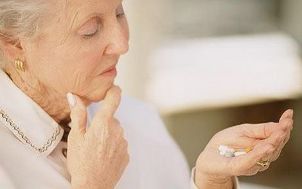 If the condition is neglected, a short course of glucocorticoids may be prescribed to increase its effect.
If the condition is neglected, a short course of glucocorticoids may be prescribed to increase its effect. - Cartilage recovery. It is necessary to stimulate the regrowth of hyaline cartilage and improve its nutrition, as well as protect it from future destruction. For this, various groups of chondroprotectors are used. If we consider the question of whether the drug helps with arthrosis of the knee joint, note the composition of the drug. The combination of essential ingredients is one of the most effective products in this category.
- Improved tissue nutrition. To speed up the healing process and strengthen the articular joints, various drugs and additives are prescribed to increase metabolism, stimulate blood circulation, and saturate cells with vitamins and minerals.
Only the attending physician has the right to prescribe and correct drug therapy for knee arthrosis. Independent use of the drug is not desirable, only the use of vitamin supplements and the use of some chondroprotectors is allowed.
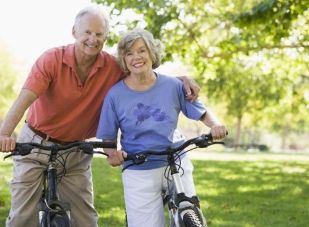
Diet and Lifestyle
An important stage in the treatment process is changing your lifestyle, especially eating habits. Much depends on the severity of the disease, for example, cycling at the beginning of development can be beneficial and stimulate the recovery process.
At the same time, when problems with bending extension movements arise, such a load can only worsen the patient's condition and worsen the destructive process.
In general, activity is encouraged, as movement helps treat many diseases of the musculoskeletal system. In this case, it is very important to observe the rest of the regimen, not to burden the feet, and to avoid sudden movements.
In particular, the question of whether the possibility of running with arthrosis of the knee joint is being considered. It is better to replace physical activity like this with brisk walking.
If we talk about nutrition, contraindications to gonarthrosis are related to alcohol and snack intake. It is very important to exclude fatty and salty foods.
Diet should be as close as possible to healthy foods, including vegetables and fruits, grains, milk and cheese, lean meats and fish. Products that help restore hyaline cartilage are very useful: seafood, entrails, jellies, apples, algae, etc.
Physiotherapy and other procedures
Physiotherapy is a mandatory component of treatment. Modern medicine also uses a variety of manual and non-traditional methods to influence the body. It is recommended to observe such a procedure.
- Magnetotherapy. This is one of the physiotherapy techniques. The magnetic effect stimulates the recovery process, enhances the effect of the drug. Electrophonophoresis can also be used as an alternative.
- Sort. Various types of manual interventions should be performed by a qualified specialist based on the diagnostic results and prescriptions of the attending physician. Massage stimulates metabolic processes in tissues, improves leg movement, relieves discomfort.
- Hirudotherapy. This is a leech treatment. Leeches are known for their safe blood purification. They bite the patient's skin, and substances that prevent blood clots from entering with saliva. Small bleeding like this helps eliminate the inflammatory process, improves tissue nutrition and affects the general health of the body.
- Acupuncture. This is one of the methods of reflexology, the point is to affect the active points located not only in the diseased area, but also throughout the body. The doctor inserts a special needle into the skin precisely at the points that need to be used to solve the problem of gonarthrosis.
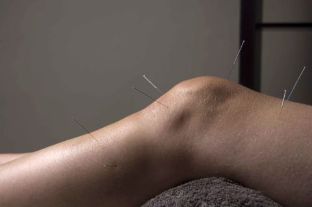
Recovery gymnastics
If we take a closer look at treatment with the help of physical training, it should first be noted that the norms of permissible load are set by the specialist. It is best to attend group exercise therapy classes. Sports for knee arthrosis are included in mandatory programs, including during postoperative recovery.
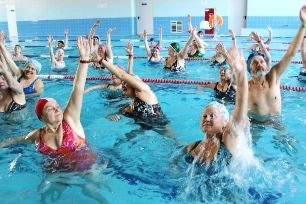
Let's highlight the main clues used for gonarthrosis:
- Swimming pool. Swimming relieves pressure and tension from the feet and helps to develop problem areas smoothly. In particular, water aerobics is useful for arthrosis of the knee joint, especially for overweight people and the elderly.
- Climb. There is no doubt about the question of whether walking is useful for gonarthrosis, but at the same time walking should be short and regular. But walking is not recommended as a method of treatment.
- Training with a simulator. This can be a special block trainer or, for example, an exercise bike, if you have no contraindications. They are useful for strengthening muscles and ligaments.
- Recovery gymnastics. Orthopedic doctors and professional rehabilitation therapists make special exercises that help train all groups of joints gently and restore their health.
Physical activity for arthrosis of the knee joint should be done regularly and in strict doses. If your feet are excessive or skip class, there will be no good effect. It is also important to choose the right training for your specific situation. Check this point first with the curator, for example, is it possible to squat with arthrosis in your case.
Traditional medicine
Also, the treatment of arthrosis of the knee joint at home is closely related to the use of traditional medicine recipes. Keep in mind that before using one or another self-prescribed medication, you need to make sure that there are no allergies and other contraindications, and also consult a doctor.
Otherwise, the effects can be reversed, or the effects of home treatment can increase the effects of medicines in pharmacies. Even so, folk methods are still in demand, as the price is much lower than most medicines purchased.
For gonarthrosis, the following medications are most commonly used:
- Herbal tea. Infusions and decoctions of bay leaf, chamomile, St. John's wort, yarrow and other medicinal plants are actively used for external and internal use. They can relieve inflammation, relieve pain, remove salt, and even nourish the body with vitamins and other useful substances.
- Beekeeping Products. Propolis, perga, bee stings, wax and honey have omnidirectional healing effects. That is why the treatment of knee joint arthrosis with honey is a popular direction. However, keep in mind that bee products can cause severe allergies, so make sure first that the product is safe to use.
- Alcohol tincture. It is an excellent remedy for warming up and stimulating blood flow, relieving inflammation and improving leg movement. For the joints, purple and white are very useful, which must be cleaned of green and filled with vodka for two weeks. Next, the infusion is used to rub the affected area.
- Fresh Plants. You can also use nature gifts. For example, the leaves of burdock or white cabbage must be kneaded slightly, and then tied to the knee for at least 10 hours. You can use prefabricated compresses, for example, add medical bile, sunflower oil, honey, etc.
- Animal fat. They are added to homemade creams. To create optimal consistency, fat must be mixed with beeswax, herbal ingredients and other components can be added.
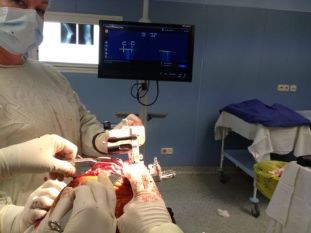
Surgery and surgical recovery
A large number of patients are concerned with the question: can knee joint arthrosis be cured once it has entered stages 2 - 3? Unfortunately, it is not possible to restore the health of the cartilage layer, but there is still a way out of the situation.
If you have arthrosis of the knee joint, treatment options are divided into surgical and conservative techniques. If the cartilage is completely worn out, just by performing surgery, the damaged limb function can be restored.
The best option is to use endoprostheses. In this case, the damaged articular joint elements are removed partially or completely, and a special prosthesis is installed in place using bolts and surgical cement. Over time, they will overgrow bone tissue and will bear all the necessary loads.
Since knee joint arthrosis treatment methods are not always feasible, arthrodesis methods are used as an alternative to reduce pain and prevent limb deformities.
If in the first case the motor ability of the foot is maximally restored, with arthrodesis the opposite effect appears - the limb is mounted in a certain position, and after cutting the bones, the elements merge. Therefore, movement will only be available in one direction.
Disease Prevention
To prevent the development of this disease, it is necessary to prevent arthrosis of the knee joint.
To do this, follow these guidelines:
- avoid injury;
- do not burden the knee;
- less nervous;
- lead an active lifestyle;
- let go of bad habits;
- eat properly;
- note your weight;
- Treat other diseases in a timely manner.
At first glance, see your doctor to start fighting the disease in a timely manner.

























